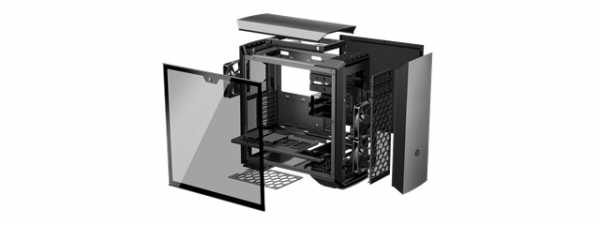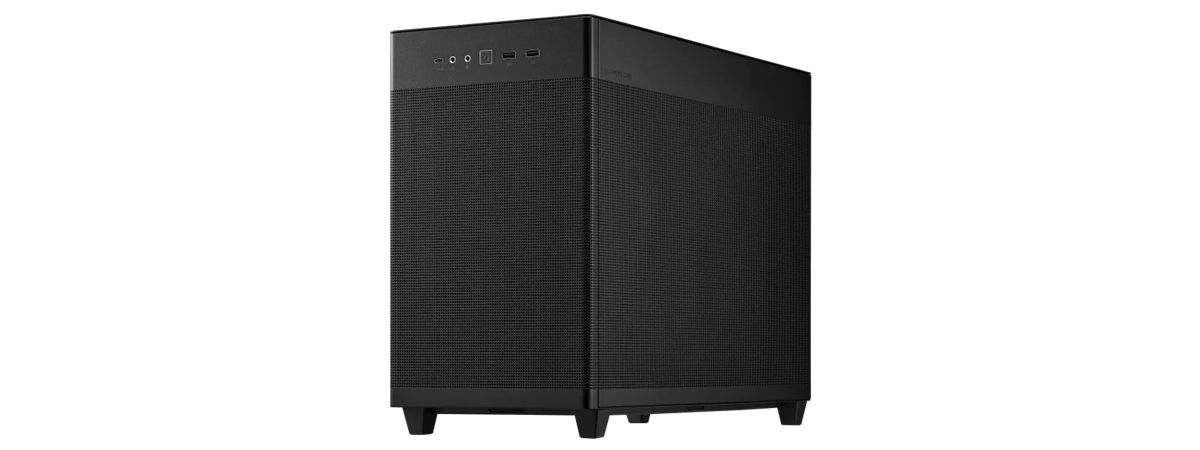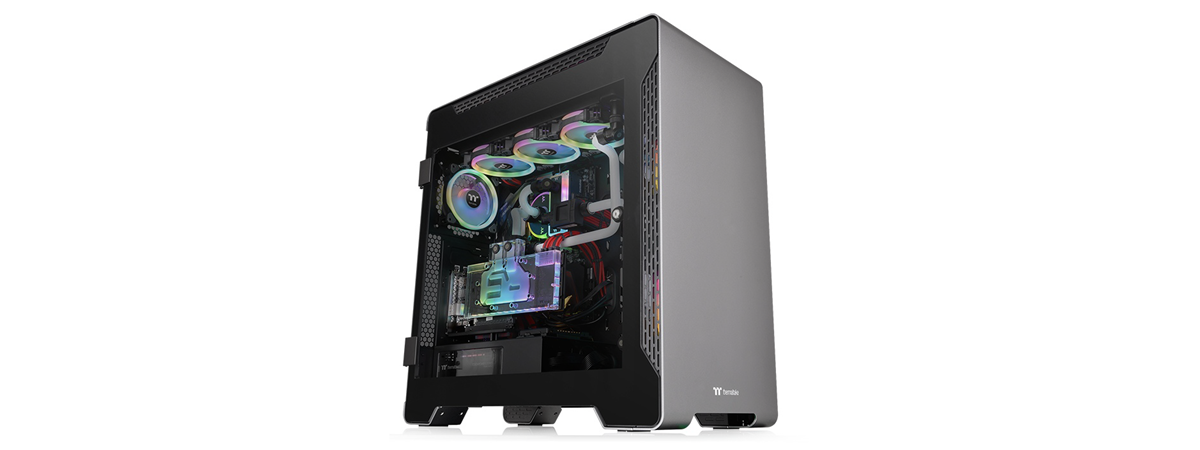
We recently found ourselves needing a new computer case that would be larger than average, with great ventilation, and, preferably, a nice design. After a couple of weeks of researching, we stumbled upon a slightly older model from Thermaltake, namely the A700 TG. The company advertises it as having an elegant design, good cooling, and modular interior. We decided to buy one and, after receiving it, building our PC, and using it for a while, we’d like to share with you what we like and don’t like about it. If you’re curious to know more about the Thermaltake A700 TG, read our review:
Thermaltake A700 TG: Who is it good for?
The Thermaltake A700 TG is an excellent computer case for:
- People who want to build a powerful computer and need a large case for it
- Those who have a lot of hardware components to install in their new computer case
- Users who intend to use large cooling solutions or even custom water cooling in their PC
Pros and cons
The Thermaltake A700 TG has more than a few good things going for it:
- Minimalistic design that looks gorgeous
- Thick tempered glass doors and metallic panels
- Extremely spacious interior
- Modular design that lets you add and remove parts of the case depending on your needs
- Efficient ventilation grilles and plenty of dust filters
- The case allows you to install your GPU card vertically
- Cable management is good
There are a few downsides to consider:
- Expensive, although it’s not something unnatural considering the high quality of the materials used
- There are only two fans included, and they’re not with RGB
- The case is heavy and massive, so it’s not for everyone…

Verdict
The Thermaltake A700 TG impressed us with its huge size and premium build quality. The manufacturer didn’t compromise on the materials used to create this computer case, and the minimalistic design is simply gorgeous. On the same note, the interior space is extremely generous, and the modular approach is something every PC case out there should have. Overall, we like the Thermaltake A700 TG a lot, and we recommend it to any gamer or PC enthusiast who wants a larger-than-life case for their hardware and to anyone interested in building a water-cooled computer.
Unboxing the Thermaltake A700 TG
The Thermaltake A700 TG is a full tower case and, accordingly, the box in which it arrives is huge and heavy. The package is made of glossy black colored cardboard and, on it, you can see what the computer case looks like when fully equipped.
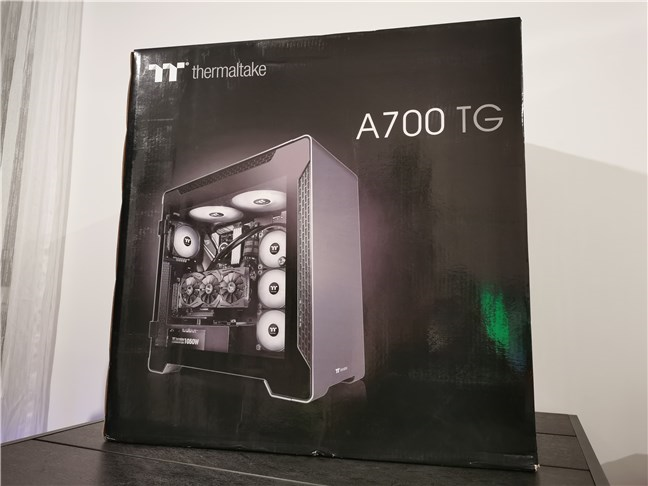
The packaging used for Thermaltake A700 TG
Being so large and heavy, it’s recommended that you ask a friend to help you with unpacking everything. At least if you want to protect your back. 🙂 Once you manage to pull it out of its box and get everything out, you get to see the Thermaltake A700 TG in all its massive beauty.
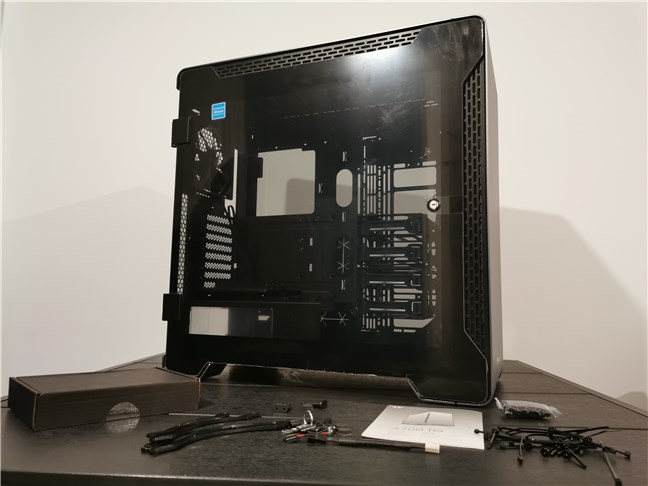
Thermaltake A700 TG and the bundled pieces and bits
Together with it, the manufacturer bundles many screws of different types, zip ties, foam pieces for the power supply unit, fan mounting brackets, a three-pin fan adapter, two keys for the glass doors, and also the user manual.
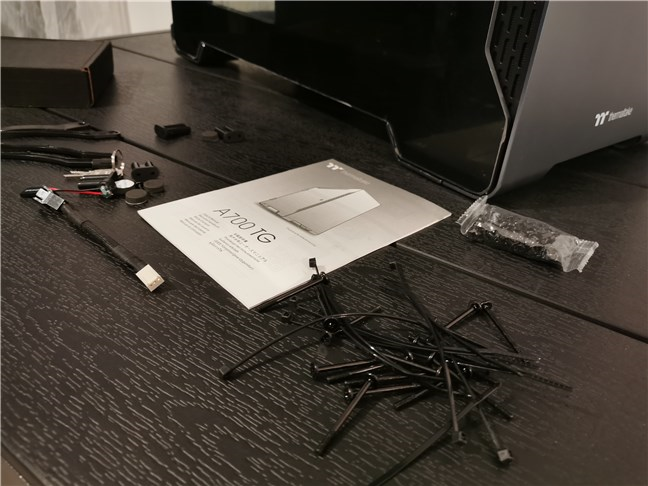
Accessories bundled with the Thermaltake A700 TG
Unboxing the Thermaltake A700 TG computer case is a satisfying experience. The bundle is generous, and the case looks beautiful and massive.
Hardware specifications and design
With the A700 TG computer case, Thermaltake didn’t make any compromises in terms of materials used. Their quality is top-notch, and everything looks gorgeous. The first thing that catches your eye is the beautiful gray metallic finish on its top and front sides. On the front part, everything’s as minimalistic as it can be, with just the Thermaltake logo printed towards the bottom.
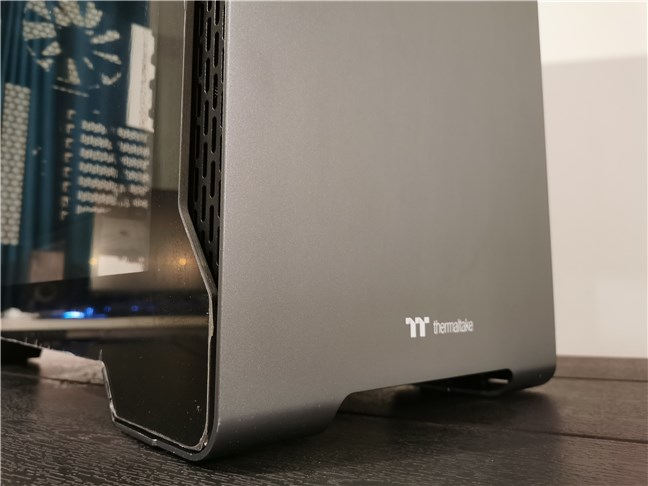
The bottom-front side of the Thermaltake A700 TG PC case
The minimalistic design continues on the upper side of the case, where the surface is clean of any nonsense. The only things you get to see and use here are the two essential buttons (power and reset), the ports (two USB 3.0 Type-A and one USB 3.0 Type-C, two USB 2.0, and one 3.5mm audio jack and one 3.5mm mic jack), as well as one LED that indicates the SSD/HDD activity.
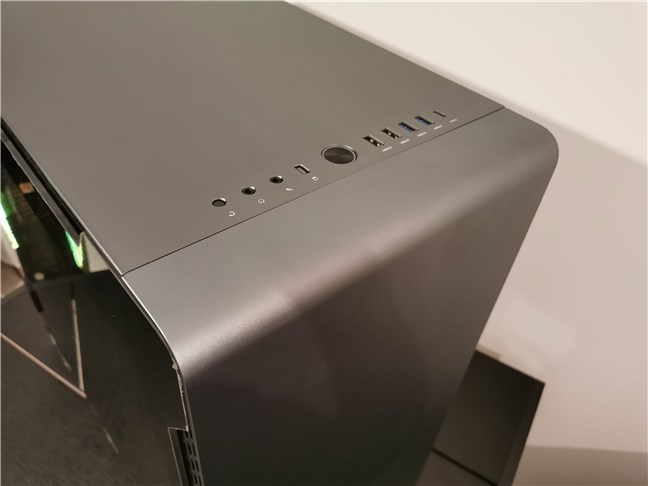
The top-front side of the Thermaltake A700 TG
Both lateral sides of the A700 TG are covered by tempered glass panels. They are slightly tinted, but just enough so that you can still easily see all the hardware components inside. Although we love being able to see the motherboard and everything mounted on it, maybe it would have been better if the right panel had only a smaller glass window on it, or maybe a darker shade. That might have made it easier to hide the inherent cable mess underneath it. Of course, that’s true only for those who are not so great at cable management. 🙂
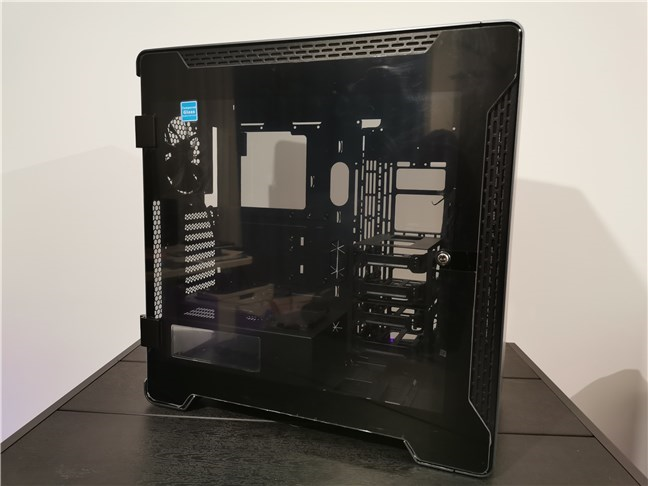
Thermaltake A700 TG comes with tempered glass doors on both sides
Regarding ventilation, the Thermaltake A700TG comes with large venting areas, but they are cleverly hidden. Both the front (under which there’s a built-in 140mm fan already mounted) and top vents are covered by the metallic panels, sitting beneath those and the glass doors. By the way, the top and front panels can be popped out to get easy access to the already mounted coolers or to mount new ones. Furthermore, you can also take out the glass panels on the left and right - it makes it easier to assemble everything inside the case. They’re held in place each by two hinges on the back, so just open the glass panels halfway and pull them upwards to get them out.
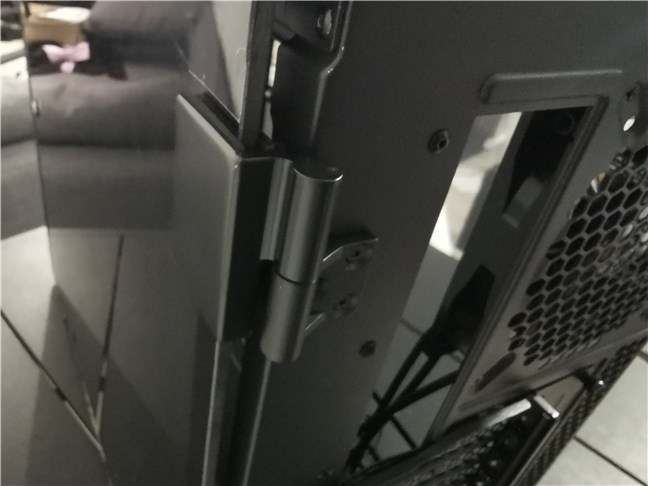
The glass doors can be taken out of their hinges
On the rear end of the case, there’s the regular hole for the motherboard’s input/output panel, a rear fan space (holding an included 140mm exhaust fan), the PCI brackets, and the power supply unit cutout. A defining aspect of the Thermaltake A700 TG is the design of the PCIe brackets assembly. While its positioning is horizontal by default, you can rotate it if you want to mount your PCIe cards vertically. That’s something many will love, as it allows you to easily mount your graphics card vertically, making your PC look more beautiful. 🙂 Unfortunately, the computer case doesn’t bundle a PCIe riser cable, so you’ll need to buy one separately for that.
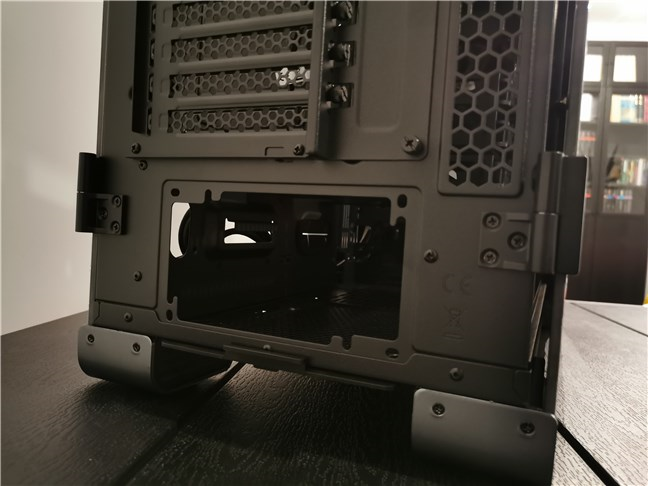
The PSU cutout on the bottom-back side of the Thermaltake A700 TG
On the bottom of the case, under the power supply to the front, there is a large detachable air filter. Also, it’s worth noting that the feet of the A700 TG are pretty tall, so the ventilation is excellent here too.
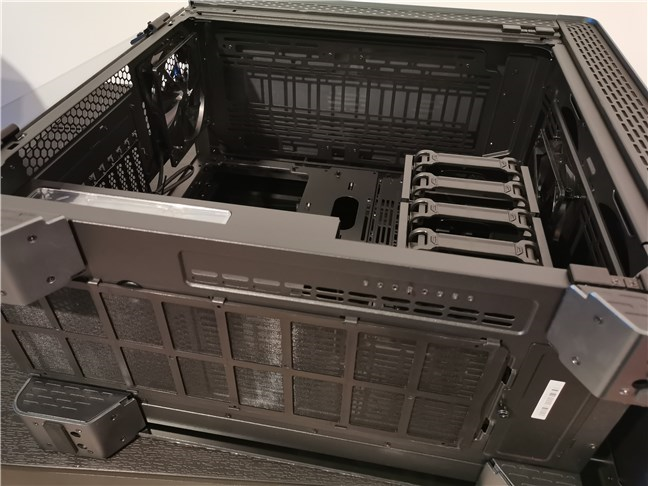
The bottom dust filter on the Thermaltake A700 TG is removable
To end this section of our review on the same note as we started it, the Thermaltake A700 TG is huge: 582 x 294 x 596 mm (22.91 x 11.6 x 23.46 inch) in height by width by depth, weighing no more, no less than 20.05 kg (44.2 lbs). Its very generous dimensions make it extremely spacious inside, able to easily fit any motherboard format: E-ATX, ATX, Micro ATX, and Mini ITX.
For all the technical specifications, check Thermaltake’s official webpage: A700 TG Specifications.
Assembling your PC inside the Thermaltake A700 TG
After we received the A700 TG, the first thing we did was, obviously, to start building a PC using it. First, the motherboard: mounting our ASUS ROG Crosshair VIII Hero Wi-Fi was fast. All the standoffs required were already placed in the right positions, and the vast interior space of the case made it easy to handle and install the mainboard.
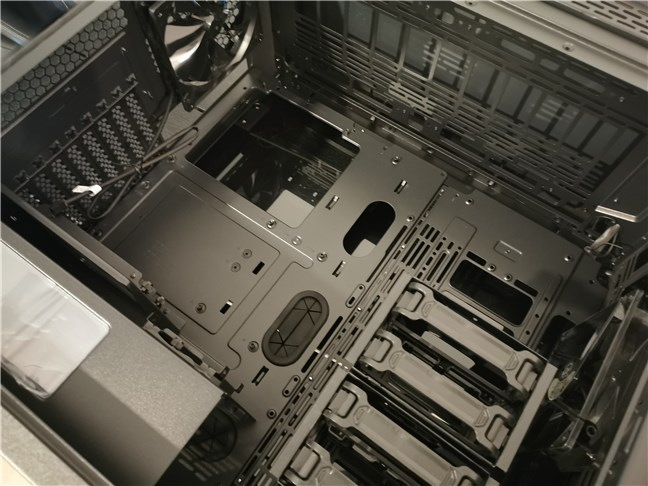
The interior of the Thermaltake A700 TG
After inserting the processor into its socket, we mounted the AIO cooler. We used the Cooler Master MasterLiquid ML360R RGB AIO, a 360mm cooling solution. Thermaltake’s A700 TG allows you to install radiators of up to 420mm on the front or right, and radiators of up to 360mm on the front, top, or right side of the case. We chose to place our AIO cooler at the top of the case, as we believe that’s the best option for such devices, considering how they’re designed to work and pump the liquid inside. Again, the spacious interior and the removable panel on the top of the case made it very easy to install the AIO.
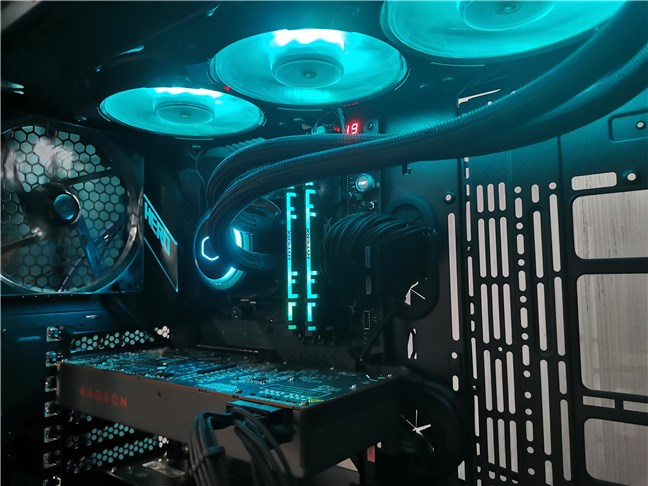
Mounting an AIO cooler at the top of the case
Next, we mounted the RAM modules and NVMe solid-state drives, after which we started installing the SATA drives. We had one 2.5” SSD and one 2.5” HDD. While we decided to install them on the back of the motherboard, the case also allows you to mount such drives, and 3.5” drives too, in one of the two drive enclosures found in front of the motherboard, towards the front side of the case. By the way, if you still have large 3.5” drives, you don’t even need screws - you just insert them into the special plastic trays from the drive enclosures.
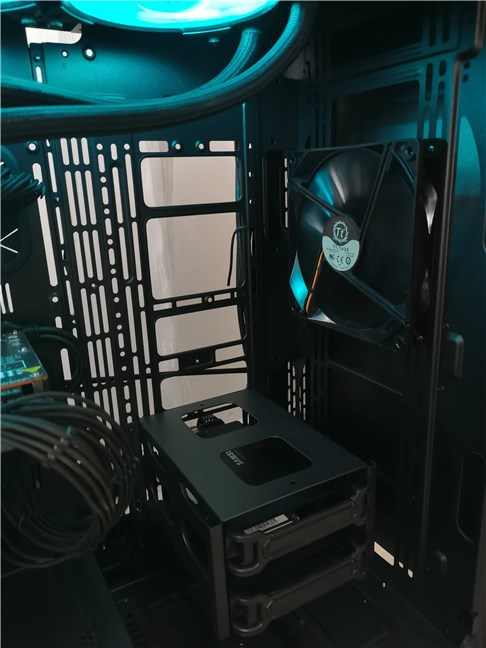
The drive enclosures can be removed
The graphics card we use is not extremely large, but it’s not small either (contrary to how it looks from the pictures). We have an AMD Radeon RX5700 that occupies two PCIe slots and has a length of 268mm (10.55 inches). There’s plenty of space for it even with the drive enclosures mounted. Speaking of which, with it mounted, the case can fit GPU cards with a length of up to 310mm. Without the drives enclosure, it can fit even longer graphics cards, of up to 410mm! We don’t know any video cards that are that long… 🙂 But, who knows, maybe in the future we’ll see such monsters surface on the market.
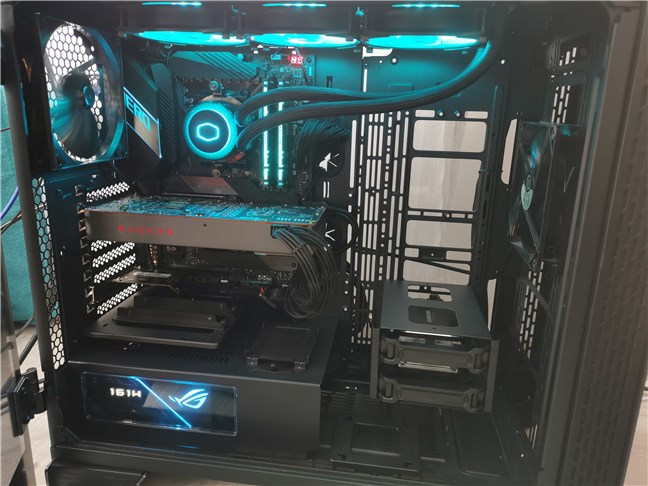
The case can fit extremely long graphics cards
The last main hardware component we installed was the power supply unit, an ASUS ROG Thor 850W Platinum. By default, the case doesn’t allow you to just slide the PSU into its place. You have to either get the drive enclosures out or remove the PSU shroud first. We chose to do the latter, as it also allows for easier handling of power cables. There are a couple of screws you have to work on, but nothing scary. Once we mounted the power supply unit, we were happy to see that the transparent cutout on the shroud allowed us to see the wattage screen on our PSU. It’s nice to always be up to date with how much electricity your computer draws from the wall.
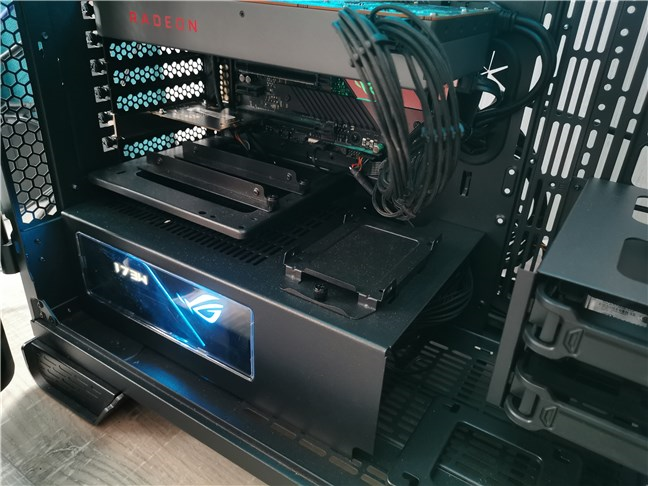
The PSU shroud can be removed also
Finally, the cable management part. Although the back of the motherboard and everything you install on that side is visible through the tempered glass door, hiding cables from view is actually not that hard. You can route the bulk of cables through the channel on the bottom of the case, and the velcro strips help with keeping them in place too.
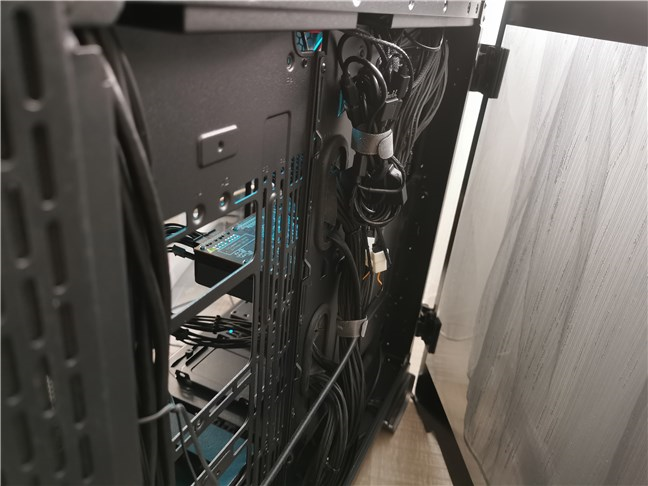
Some sort of cable management 🙂
The end result was a beautiful computer in our opinion. The glass doors allow you to marvel at your hardware, while the metallic finish on top and front look classy, even if the case itself is massive. After a couple of weeks since we’ve built this PC, we’re very pleased not only by its looks, but also by the airflow and quietness the case offers. Maybe the only thing some people might want to add is some sort of RGB lights, as the case itself has none built-in.
The Thermaltake A700 TG is a gorgeous computer case that doesn’t compromise. The sheer size makes it impossible to find anything that wouldn’t easily fit inside it, the amount of hardware component installation options is very generous, and the build quality and materials used are top-notch. We loved assembling our computer in it, and we love using the Thermaltake A700 TG.
What is your opinion of the Thermaltake A700 TG?
Now you know more about the Thermaltake A700 TG. Before leaving, let us know what you think about this massive computer case. Do you already own it? Would you recommend it to others?


 12.01.2022
12.01.2022 
